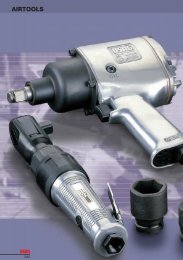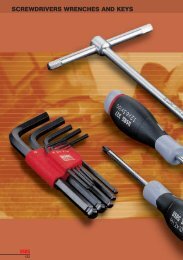Industrial seal self study guide - SKF.com
Industrial seal self study guide - SKF.com
Industrial seal self study guide - SKF.com
You also want an ePaper? Increase the reach of your titles
YUMPU automatically turns print PDFs into web optimized ePapers that Google loves.
SEAL DESIGN GROUPS (cont.)<br />
“OLD” DESIGN<br />
“NEW DESIGN”<br />
Older “clamp-type” <strong>seal</strong> (left) has<br />
been replaced by newer hydrodynamic<br />
Wave<strong>seal</strong> (right) (fig. 3qq).<br />
General purpose design for lubricated<br />
media and moderate pressure and<br />
surface speeds (fig. 3rr).<br />
Old vs. New Seal Designs<br />
Following the “original” leather strap <strong>seal</strong>s, the first engineered<br />
designs were known as “assembled” or “clamp-type” <strong>seal</strong>s. They were<br />
assembled by laying two <strong>seal</strong>ing elements and three metal spacer rings<br />
into an outer shell and clamping these <strong>com</strong>ponents together. They<br />
were wide and sturdy in appearance, and tended to apply high lip<br />
pressure to the shaft, creating shaft wear. A garter spring was placed<br />
against the primary or retention element. The <strong>seal</strong>ing lips were usually<br />
trimmed to size, using a knife.<br />
In today’s designs, the <strong>seal</strong>ing element is molded to size, and<br />
permanently bonded to a metal case (fig 3qq). In modern spring<br />
loaded molded <strong>seal</strong>s, a garter spring is snapped into a mold-formed<br />
groove in the <strong>seal</strong>ing member. Today’s <strong>seal</strong>s are narrower, lighter<br />
and less sturdy in appearance, but their designs give them uniform<br />
<strong>com</strong>pressive <strong>seal</strong>ing force. Only a thin band of lip material rubs against<br />
the shaft so they can operate at higher speeds with less friction.<br />
PTFE <strong>seal</strong>s<br />
<strong>SKF</strong> PTFE <strong>seal</strong>s (fig. 3rr and fig. 3ss) are assembled or machined,<br />
made-to-order radial shaft <strong>seal</strong>s based on PTFE (Teflon ® or<br />
polytetrafluoroethylene). This thermoplastic material has properties<br />
that exceed the capabilities of rubber <strong>com</strong>pounds. PTFE <strong>seal</strong>s can<br />
accept high surface speeds, pressure and dry running conditions and<br />
have high wear resistance and service life. Their temperature range<br />
is very wide and they resist attack by nearly all acids, solvents and<br />
chemical agents. They can be made for variety of inch or metric sizes<br />
from small to large diameter, often without any tooling charge. PTFE<br />
<strong>seal</strong>s generally require a high quality shaft finish and hardness, and<br />
are engineered to meet specific application conditions.<br />
Pressure design for service to 5<br />
psi (35 bar). Variations for vacuum<br />
and high shaft speeds (fig. 3ss).<br />
28







